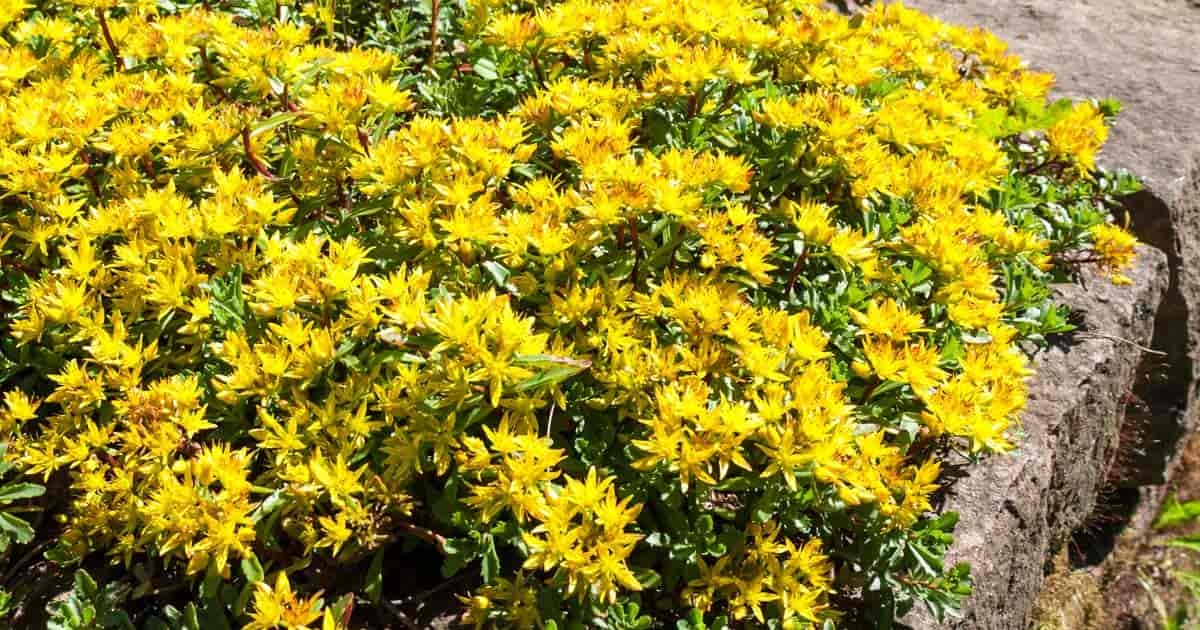Sedum Kamtschaticum [SEE-dum kam-SHAY-ti-kum] is a dense perennial sedum plant from the family Crassulaceae.
The common name for the plants is the Russian Stonecrop. The botanical name means of or from the Kamchatka peninsula region of Russia.

This stonecrop is naturally found in the Kamchatka Peninsula, is native to Northern China and the coast of Siberia.
This beautiful, easy maintenance sedum has a number of ways to augment the appearance of your garden or home.
Russian Stonecrop Sedum Kamtschaticum Care
Size and Growth
Russian sedum has a moderate, compact growth grate. The plant grows to be about 4” tall and 12” wide. It’s in season all year round but will bloom in spring to summer.
Flowering and Fragrance
This stonecrop has a spreading growth that is characterized by thick scalloped green leaves that form a thick patch across the ground.
During the late spring and summer months, it will bloom with gorgeous clusters of bright star-shaped yellow flowers.
Light and Temperature
This light loving plant enjoys plenty of sunlight and can withstand full sun to partial shade. It requires a dry to medium level of moisture in the air.
If planted indoors, it thrives best when placed by south, east, or west facing windows.
Too much shade can make the plant lose its luster so be sure that wherever you decide to place it; it’s getting plenty of light throughout the day.
This plant can tolerate cooler temperatures up to 20° degrees Fahrenheit after which it is best moved to a more protected, warmer spot.
Water and Feeding
The Russian Stonecrop is a fairly drought tolerant plant with basic watering needs.
During the early growing seasons, water the plant regularly to establish a deep root system. Once the plant has becomes established, it only needs occasional watering.
Be careful not to overwater the plant, or leave any water standing at the base. The plant is known to die when left in standing water and can be susceptible to root and crown rot if overwatered.
Russian sedums should be fed only sparingly with a general purpose fertilizer.
Soil and Transplanting
This plant works best in well-drained soil that has a slightly alkaline pH level and is moderately fertile.
Repot plants when they outgrow its current pot by moving it out to the garden or finding a larger container to hold the plant better.
Grooming and Maintenance
Generally, this plant does not require a lot of grooming or maintenance. However, you can prune your plant by cutting back flowers, so it maintains its shape over winter.
Due to its moderate growth rate and spreading growth, it is best to not plant Russian stonecrop along with other slower growing plants as it may end up stunting their growth.
Propagating Russian Stonecrop
Propagate Russian Stonecrops by division in the spring or summer months during the plant’s growing season.
Due to the plant’s spreading growth, it is suited best for using as a spiller plant or ground cover.
Stonecrop Pest or Disease Problems
This plant is generally disease free but is susceptible to fungus problems and rot if overwatered.
To avoid these issues, let your soil dry out between watering and make sure that there is no water left standing at the base of the plant.
Russian sedums are fairly rabbit resistant.
Russian Sedum Stonecrop Uses
Use this beautiful plant as a ground cover, as a container plant, or as part of a rock garden. It also works well as a border and for mass plantations.
The plant is also known to have some medicinal properties for use in the treatment cuts, snakebites, and burns.
